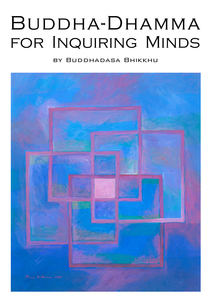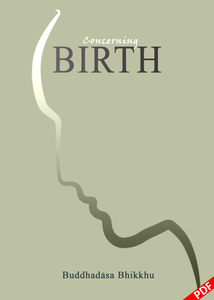Fear
Buddhadasa Bhikkhu
“In today's discussion of Ego and Mine, I'd like to discuss fear. Fear is a form of suffering that hugely disturbs human well-being. Some of that fear ought not to be so disruptive, but is. Yet, we mostly hear about lust and greed (rāga and lobha), anger and hatred (kodha and dosa), when discussing the sources of suffering. Delusion (moha), with its broad boundaries, gets less attention. Here, we will consider fear as a variety of delusion. You should situate it correctly within the three kinds of kilesa, the defilements that obscure and pollute mind's natural fre...

The World of Metteyya Is at the Tip of Our Nose
“We can create the world of Metteyya together by feeling love for one another. If everyone in the world at this time could feel love for everyone else this world would, in the blinking of an eye, or in the time it takes to throw a switch, become the world of Metteyya. So, is this right at the tip of our noses? Think about it. It is something we can do, something that, if we’re going to do it, will be done in the way explained. Whether we do or don’t do anything is for us to decide. But the truth is that the world of Metteyya is right at the tip of our nose, it’s t...

Dhamma for Sick People
Buddhadasa Bhikkhu
“This Dhamma talk is for stimulating the intelligence of people who are ill. Please read carefully and consider thoroughly. Illness ought to be seen as natural occurrences for all physical sankhāras (bodies), whether humans or other animals, because sankhāras undergo change. Whenever there is change, it can be up or down. Upward change feels comfortable and healthy. Downward change creates illness. When physical sankhāras get successively older, most of the change is painful and ill. This fact needs to be seen as it truly is: all sankhāras are just like this...”...

Paticcasamuppada: Practical Dependent Origination
Buddhadasa Bhikkhu
“The word 'paticcasamuppada' is probably still a strange and uncommon one, not often heard by most people. But since it is probably not possible to use another word, we will continue using it. It behooves all of you to try to understand the word 'paticcasamuppada' to a greater and greater degree until it comes naturally to you. Those people who have become monks and studied Buddhism have heard this word a bit, but most people will be uncertain about it, which will cause them to become uninterested. In this way, they will not come to understand the most important t...

Buddha-Dhamma For Inquiring Minds
Buddhadasa Bhikkhu
Buddha-Dhamma for Students (title of original translation) was composed of two talks given by Ajahn Buddhadāsa in January 1966 to students at Thammasat University, Bangkok. Then and in the years since, many young Thais have returned to Buddhism in search of answers and choices not provided by their modern (Western-style) education. In the face of rapid social change, at times bordering on chaos, they sought a non-violent approach to the issues and injustices of the times. Their interest is both praised and recognized as needing guidance. Applying a confused or inc...

The Liberating Teachings of Buddhadasa on Suchness
Buddhadasa Bhikkhu
The teachings in this notebook date from 1971. They are handwritten notes of the Dharma offered orally and in writing by Ajahn Buddhadasa. I lived there as a forest monk, and was drawn to Buddhadasa as Dharma revolutionary, a respected friend of Ajahn Chah, and inspiration to a whole generation. In teachings and form, Buddhadasa stepped beyond the popular forms of Thai Buddhism and offered its pith and essence. Whether in the description of Everyday Nirvana, in the language of non-selfishness instead of non self, in teachings on the void and the turning from m...

May We Leave This Legacy With You (Section I)
Buddhadasa Bhikkhu
“I have no inheritance to leave behind for Buddhist friends, my comrades in birth, aging, illness, and death, except for what is spelled out in the following statements. My hope is that for however long these legacies are passed along the activity of Suan Mokkhabalarama will continue and ‘Buddhadasa’ will remain in that place for that long. Please receive these legacies in your contemplation from this very moment which will create ease in passing them further along. May you accept them as a Dhamma inheritance for all Dhamma Comrades who have offered body and life...

A Single Bowl of Sauce : Teachings Beyond Good & Evil
Buddhadasa Bhikkhu
In this volume, I am delighted to find a pleasant mix of old pieces that many people have never seen, a few old things long out of print, some new translations, and pieces that have long been on the web and were ripe for fresh, revised publication. These many-sided examples of Tan Ajahn’s teaching supplement the longer works currently in print, such as the newly issued Under the Bodhi Tree, on dependent co-arising. In this volume, readers will find summaries of the key themes of Tan Ajahn’s Dhamma life and specific application of them to particular activities such...

Natural Cure for Spiritual Disease
Buddhadasa Bhikkhu
“This guide is translated from the first series of talks given by Ajahn Buddhadsa to foreign meditators attending the monthly courses at Suan Mokkh. It is intended for Western Dhamma friends, including those who are new to Buddhist understanding and practice. We hope that the perspectives offered here will help new students of Buddhism to get their bearings straight from the start. Those who have studied and practiced Buddhism for some time, no matter what the school or approach, should also find this guide helpful. We can never be too clear what Dhamma and Dhamma...

Displaying books 17 - 32 of 57 in total














